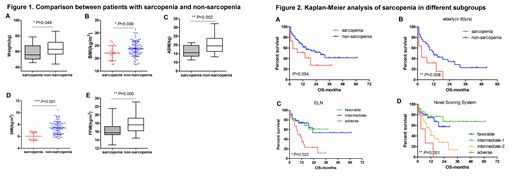Background: Acute myeloid leukemia (AML) is a malignant hematologic disease mainly occurs in the elderly. Sarcopenia is a muscle disease (muscle failure) common among adults of older age but can also occur earlier in life. This study indicates to investigate the prognostic value of sarcopenia in AML patients.
Methods: From January 2014 to April 2019, a total of 100 patients diagnosed with de novo AML according to the WHO classification were included in this study. Clinical data and biological characteristics were collected. Giemsa R-banding method was used to detect the karyotype of metaphase bone marrow cells. Targeted gene sequencing was taken to test a total of 23 gene mutations including DNMT3A, IDH1, IDH2, ASXL1, RUNX1, NPM1, CEBPA, FLT3, KIT, and TP53, etc. Bioelectrical impedance analysis (BIA) of human body before treatment was used to calculate the Body Mass Index (BMI), Appendicular Skeletal Muscle Mass (ASM), SMI (ASM/height2), Fat Mass (FM), Fat-free Mass (FFM), and FFMI (FFM/height2), etc. The diagnosis of sarcopenia was based on the consensus report of the Asian Working Group for Sarcopenia.
Results: Sixteen AML patients were diagnosed as sarcopenia. Patients with sarcopenia had significantly lower weight (P=0.049), BMI (P=0.039), ASM (P=0.002), SMI (P<0.001) and FFMI (P=0.005) than non-sarcopenia ones (Figure 1A~E). With a median follow-up time of 25 months, the overall survival (OS) of patients with sarcopenia was shorter than non-sarcopenia patients (median 7 vs. 28 months, P=0.054, Figure 2A). When stratified by age (≥60 yrs vs. <60 yrs), elderly patients with sarcopenia showed a significantly inferior OS to normal elder ones (median 3 vs. 12 months, P=0.008, Figure 2B). Receiver operator characteristic curves suggested that sarcopenia as one additional point to the 2017 European Leukemia Net risk stratification by genetics obtained superior area under the curve (AUC) in predicting AML OS than the latter alone (AUC 0.67 vs. 0.649, P=0.3305, Kaplan-Meier plotting see Figure 2C~D).
Conclusion: Sarcopenia is common in AML patients, and BIA offers a useful objective tool for identifying these patients. We illustrated a marked clinical impact of sarcopenia on patients with AML, and presented a novel prognostic scoring system. In elderly patients, the presence of sarcopenia before treatment may offer a useful factor for avoiding intensive therapeutic strategies for AML.
No relevant conflicts of interest to declare.
Author notes
Asterisk with author names denotes non-ASH members.


This feature is available to Subscribers Only
Sign In or Create an Account Close Modal